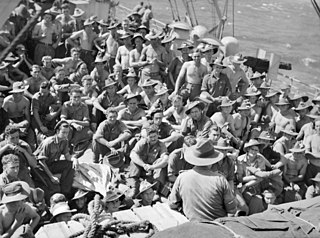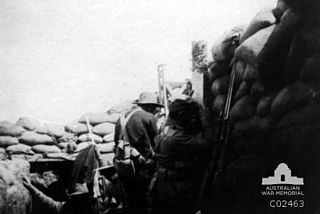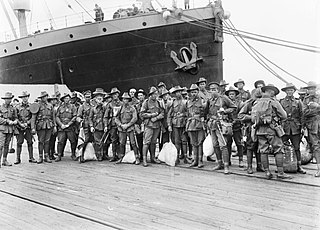
The 16th Brigade was an infantry brigade in the Australian Army. First raised in 1912 as a Militia formation to provide training under the compulsory training scheme, the brigade was later re-raised as part of the First Australian Imperial Force during World War I. Its existence was short lived, as it was disbanded after about six months, before it could be committed to the fighting on the Western Front. Raised again in 1939 for service during World War II, the brigade was deployed to the Middle East in early 1940 and subsequently saw action in the Western Desert and in Greece in 1941. In 1942, it returned to Australia in response to Japan's entry into the war, and later the brigade played a prominent role in the Kokoda Track campaign and at Buna–Gona in Papua. Withdrawn to Australia in early 1943, the 16th Brigade was re-organised and received many replacements from disbanding formations, but it was not recommitted to combat operations until late in the war. In 1944–1945, the brigade was committed to the Aitape–Wewak campaign in New Guinea. After the war, the brigade was disbanded in 1946. Today, its name is perpetuated by the 16th Aviation Brigade which was raised on 2 April 2002.

The 36th Battalion was an infantry battalion of the Australian Army. It was originally raised in 1916 as part of the First Australian Imperial Force during World War I. Throughout World War I the battalion served on the Western Front as part of the 9th Brigade, attached to the 3rd Division. Due to heavy casualties amongst the AIF and a decrease in the number of replacements arriving from Australia in 1918, the battalion was disbanded before the war ended in order to reinforce other units in France. The 36th Battalion was re-raised in 1921 as part of the Militia based in Sydney. During World War II the battalion was attached to the 14th Brigade and was initially used in a defensive role as a garrison unit in Australia before being sent to New Guinea in 1942. Throughout the course of the war in the Pacific, the 36th Battalion spent most of the 1942–45 period overseas in New Guinea and New Britain where they undertook operations against the Japanese. In June 1945 they were returned to Australia and shortly afterwards the battalion was disbanded.

The 4th Battalion was an infantry battalion of the Australian Army. Originally raised as part of the First Australian Imperial Force during the First World War, the battalion formed part of the 1st Brigade, attached to the 1st Division. During the war the battalion fought at Gallipoli and in the trenches on the Western Front, before being disbanded in 1919. In 1921, the battalion was re-raised as a militia unit and designated as the "4th Battalion ", adopting the designation of the Australian Rifles militia unit from which many of the battalion's recruits had come during the war. In 1930, the battalion was amalgamated with the 3rd Battalion and they remained linked until 1936, when they were delinked.
The 5th Battalion was an infantry battalion of the Australian Army. Raised in Victoria as part of the First Australian Imperial Force for service during World War I, the battalion formed part of the 2nd Brigade, attached to the 1st Division. It participated in the landing at Anzac Cove on 25 April 1915, coming ashore in the second wave, before taking part in the fighting at Krithia and then at Lone Pine. In December 1915 the battalion was withdrawn from the peninsula and returned to Egypt where it was involved in defending the Suez Canal until being transferred to the Western Front in France in early 1916. After that, over the course of the next two and a half years the 5th Battalion was rotated in and out of the front line and took part in a number of significant battles including at Pozieres, Ypres, Amiens and the Hindenburg Line. Following the end of the war, the battalion was disbanded and its personnel returned to Australia. The battalion was re-raised during the inter-war years as a part-time unit and was later mobilised during World War II, but did not serve overseas. During the post war period, the battalion has existed at various times before being subsumed into the 5th/6th Battalion, Royal Victoria Regiment.

The 16th Battalion, Royal Western Australia Regiment is an Australian Army reserve infantry battalion located in Western Australia and one of the two battalions of the Royal Western Australia Regiment. The battalion was first formed during the First World War, during which it fought during the Gallipoli Campaign and on the Western Front in France and Belgium as part of the Australian Imperial Force. It was re-formed as a part-time unit in Western Australia during the inter-war years, and served in the New Britain Campaign against the Japanese during the Second World War. In the post war years, the battalion became part of the Royal Western Australia Regiment and currently forms part of the 13th Brigade.

The 35th Battalion was an infantry battalion of the Australian Army. Originally raised in late 1915 for service during the First World War, the battalion saw service on the Western Front in France and Belgium before being disbanded in 1919. In 1921, it was re-raised in the Newcastle region of New South Wales as a unit of the Citizens Force. It was subsequently amalgamated a number of times during the inter-war years following the Great Depression, firstly with the 33rd Battalion and then the 2nd Battalion, before being re-raised in its own right upon the outbreak of the Second World War. Following this the battalion undertook garrison duties in Australia before being deployed to New Guinea where they took part in the Huon Peninsula campaign. After the end of the war, the 35th Battalion was disbanded in early 1946.

The 26th Battalion was an infantry battalion of the Australian Army. Originally raised in April 1915 for service in World War I as part of the Australian Imperial Force (AIF), it was assigned to the 7th Brigade and consisted of personnel recruited from the states of Queensland and Tasmania. The battalion fought at Gallipoli in the latter stages of that campaign before being withdrawn to Egypt in late 1915. In mid-1916, it was sent to Europe where it served in the trenches of the Western Front in France and Belgium for the rest of the war, fighting in most of the battles that the Australians took part in between 1916 and 1918. At the end of the war, it was disbanded in May 1919 as part of the demobilisation of the AIF.

The 18th Battalion was an infantry battalion of the Australian Army. During World War I, the battalion was raised in 1915 as part of the Australian Imperial Force, attached to the 5th Brigade, of the 2nd Division. It was sent initially to Gallipoli, where it suffered many casualties before it was withdrawn from the line and sent to France and Belgium, where it served at the Western Front as part of the Australian Corps and took part in most of the major battles between 1916 and 1918. The battalion's last engagement of the war was at Montbrehain in October 1918 and it was disbanded in April 1919.

The 31st Battalion, Royal Queensland Regiment was a Reserve infantry battalion of the Australian Army. Although it was officially formed as 31 RQR in 1965 the battalion can trace its lineage back to units formed in 1881 as part of the colonial defence forces of the state of Queensland.

The 32nd Battalion was an infantry battalion of the Australian Army. It was first raised in 1915 as part of the all-volunteer Australian Imperial Force for service during the First World War, and was initially made up of personnel from South Australia and Western Australia. The battalion served in France and Belgium in 1916–1918 before being disbanded in 1919.

The 27th Battalion was an infantry battalion of the Australian Army. It was initially raised in 1915 as part of the all-volunteer First Australian Imperial Force for service during World War I. During the conflict, the battalion saw action briefly at Gallipoli before later fighting on the Western Front between 1916 and 1918. It was disbanded in 1919, but was re-raised in 1921 as part of the Citizens Force, which later became the "Militia". During World War II the battalion was used mainly in a garrison role until the last year of the war when it was committed to the fighting against the Japanese during the Bougainville campaign. Following the end of hostilities it was disbanded in May 1946. Between 1948 and 1965 the battalion was re-raised and disbanded a number of times before eventually becoming part of the Royal South Australia Regiment. It was disbanded for a final time in 1987, when it was amalgamated with the 10th Battalion, Royal South Australia Regiment to form the 10th/27th Battalion, Royal South Australia Regiment.

The 21st Battalion was an infantry battalion of the Australian Army. It was raised in 1915 as part of the First Australian Imperial Force for service during World War I and formed part of the 6th Brigade, attached to the 2nd Division. It fought during the Gallipoli campaign and on the Western Front before being disbanded in late 1918. The battalion was the first Australian battalion to commence active operations on the Western Front and also had the distinction of being the last to pull back when the Australian Corps was withdrawn from the line. In 1921, the battalion was re-raised as a part-time unit of the Citizens Force but was later amalgamated with the 23rd Battalion in 1929 to form the 23rd/21st Battalion.

The 47th Battalion was an infantry battalion of the Australian Army. It was originally raised in 1916 for service during the First World War and took part in the fighting in the trenches of the Western Front in France and Belgium before being disbanded in early 1918 to provide reinforcements for other Australian units that were suffering from a manpower shortage following the German Spring Offensive. In 1921, it was re-raised as a part-time unit of the Citizens Force, which later became the Militia. During this time it was based in south-east Queensland and in 1927 it became known as the "Wide Bay Regiment". During the Second World War the 47th Battalion took part in fighting in New Guinea and Bougainville, before being disbanded again in January 1946. Later, the battalion was re-raised before eventually being subsumed into the Royal Queensland Regiment in 1960.

The 29th Battalion was an infantry battalion of the Australian Army. First formed in 1915 for service during the First World War as part of the Australian Imperial Force (AIF), it fought in the trenches of the Western Front in France and Belgium before being disbanded in late 1918 to provide reinforcements for other heavily depleted Australian units. In 1921, following the demobilisation of the AIF, the battalion was re-raised as a unit of Australia's part-time military forces, based in Melbourne, Victoria, before being amalgamated with the 22nd Battalion in 1930. It was later re-raised in its own right and, following the outbreak of the Second World War, undertook garrison duties in Australia before being amalgamated with the 46th Battalion to form the 29th/46th Battalion in late 1942, subsequently seeing service against the Japanese in New Guinea and on New Britain.

The 56th Battalion was an infantry battalion of the Australian Army. It was originally raised in 1916 for service during the World War I and took part in the fighting in the trenches of the Western Front in France and Belgium before being amalgamated with the 54th Battalion in late 1918 following the German Spring Offensive reduced the numbers in both battalions. After the war, the battalion was re-raised as a part-time unit in New South Wales. During World War II the battalion was mobilised and undertook garrison duties in Australia until it was disbanded in 1944. It was briefly re-raised in 1956, but was disbanded the following year and its personnel used to re-raise the 4th Battalion, which later became part of the Royal New South Wales Regiment.

The 52nd Battalion was an infantry battalion of the Australian Army. It was originally raised in 1916 as part of the Australian Imperial Force for service during World War I. After training in Egypt, the battalion took part in the fighting in the trenches of the Western Front in France and Belgium, including major battles at Mouquet Farm, Messines, Polygon Wood, Dernancourt and Villers-Bretonneux. In May 1918, the battalion was disbanded to provide reinforcements for other depleted Australian units. After the war, the battalion was re-raised as a part-time unit in Victoria in 1921 and served until 1930 when it was amalgamated with the 37th Battalion to become the 37th/52nd Battalion. In 1936, the battalion was re-formed and during the early part of World War II it undertook garrison duties in Australia before being merged once again with the 37th Battalion in 1942.

The 22nd Battalion was an infantry battalion of the Australian Army. It was raised in 1915 as part of the Australian Imperial Force for service during World War I and formed part of the 6th Brigade, attached to the 2nd Division. It fought during the Gallipoli campaign and on the Western Front before being disbanded in 1919. In 1921, it was re-raised as a part-time unit and was merged with the 29th Battalion in 1930 to form the "29th/22nd Infantry Battalion". Split in August 1939 and known as the "22nd Battalion ", the battalion saw action against the Japanese during World War II in the Huon Peninsula and New Britain campaigns. The battalion was disbanded in June 1946. It was re-established as part of the Royal Victoria Regiment in the mid-1960s as a remote area battalion within the Citizens Military Force, and later became a part of the 8th/7th Battalion, Royal Victoria Regiment.

The 42nd Battalion was an infantry battalion of the Australian Army. Raised as part of the Australian Imperial Force (AIF) during the First World War, it was established at Enoggera in December 1915, forming part of the 11th Brigade in the 3rd Division. It subsequently served on the Western Front in France and Belgium in 1916–18 before being disbanded on 22 October 1918. In 1921, the battalion was reformed as part of the Citizens Forces becoming known as the 42nd Battalion. Following the outbreak of the Second World War the battalion held a number of training exercises and camps until 1941, before being mobilised in March 1942 as part of the 29th Brigade, in the 5th Division. It subsequently served in New Guinea fighting against the Japanese during 1943–44 and on Bougainville in 1945, before being disbanded on 7 May 1946. In 1948, it was reformed as part of the re-raised Citizens Military Forces. Today, its lineage is perpetuated by the 31st/42nd Battalion, Royal Queensland Regiment, a unit which continues to serve in the Australian Army Reserve.

The 5th Machine Gun Battalion was an infantry support unit of the Australian Army. Originally formed in March 1918 for service during World War I as part of the all volunteer Australian Imperial Force, it was one of five such units raised as part of the AIF during the war. The battalion consisted of four machine gun companies, which had previously existed as independent companies assigned mainly at brigade level. The battalion took part in the final stages of the war, seeing action during the Allied defensive operations during the German Spring Offensive and then the Allied Hundred Days Offensive, which finally brought an end to the war. The battalion was disbanded in mid-1919 during the demobilisation of the AIF following the conclusion of hostilities. During World War II, the battalion was re-raised as part of the Militia in September 1942, and undertook garrison duties in the Torres Strait, until it was disbanded in May 1944.

The 20th Pioneer Battalion was an Australian Army pioneer unit that served in New Guinea during World War II. A Militia unit, the battalion was originally formed as a light horse regiment in 1918. Through the 20th Light Horse Regiment, the unit drew lineage back to early Victorian colonial forces, raised in 1885. During the early part of World War II, the unit was converted from a light horse regiment to a motorised unit – the 20th Motor Regiment – and undertook defensive duties in Victoria and then Queensland. In 1944, it deployed in a dismounted role to Merauke in Dutch New Guinea, to defend the Allied airfield that had been constructed there. The unit was later converted into a pioneer battalion in early 1945, deploying to New Guinea in the final stages of the war. It was disbanded in November 1945.


















